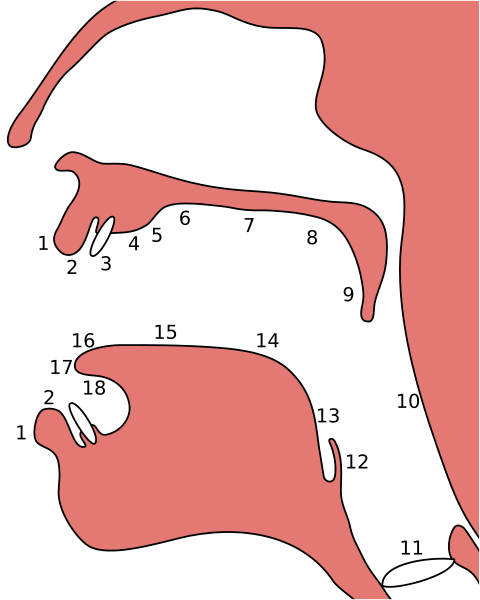File:Places of articulation.svg
From Vigyanwiki
Places of articulation.svg

Size of this PNG preview of this SVG file: 480 × 600 pixels. Other resolutions: 192 × 240 pixels | 384 × 480 pixels | 614 × 768 pixels | 819 × 1,024 pixels | 1,638 × 2,048 pixels.
Original file (SVG file, nominally 800 × 1,000 pixels, file size: 32 KB)
This file is from Wikimedia Commons and may be used by other projects. The description on its file description page there is shown below.
Summary
| DescriptionPlaces of articulation.svg |
Русский: Места образования согласных (активные и пассивные): 1. Внешнелабиальные, 2. Внутрилабиальные, 3. Дентальные, 4. Альвеолярные, 5. Постальвеолярные, 6. Препалатальные, 7. Палатальные, 8. Велярные, 9. Увулярные, 10. Фарингальные, 11. Глоттальные, 12. Эпиглоттальные, 13. Радикальные, 14. Постдорсальные, 15. Предорсальные, 16. Ламинальные, 17. Апикальные, 18. Субапикальные |
|||
| Date | ||||
| Source |
Deutsch: Minifie et al. (1973:); Orte aus Catford (1977)
English: sagittal section image based on Minifie et al. (1973:); articulation places are from Catford (1977) |
|||
| Author | created by User:ish shwar (original .png deleted), .svg by Rohieb | |||
| Permission (Reusing this file) |
GNU FDL, CC-BY-SA-2.5 |
Licensing
I, the copyright holder of this work, hereby publish it under the following licences:

|
Permission is granted to copy, distribute and/or modify this document under the terms of the GNU Free Documentation Licence, Version 1.2 or any later version published by the Free Software Foundation; with no Invariant Sections, no Front-Cover Texts, and no Back-Cover Texts. A copy of the licence is included in the section entitled GNU Free Documentation Licence.http://www.gnu.org/copyleft/fdl.htmlGFDLGNU Free Documentation Licensetruetrue |
| This file is licensed under the Creative Commons Attribution-Share Alike 3.0 Unported licence. | ||
| ||
| This licensing tag was added to this file as part of the GFDL licensing update.http://creativecommons.org/licenses/by-sa/3.0/CC BY-SA 3.0Creative Commons Attribution-Share Alike 3.0truetrue |
This file is licensed under the Creative Commons Attribution-Share Alike 2.5 Generic licence.
- You are free:
- to share – to copy, distribute and transmit the work
- to remix – to adapt the work
- Under the following conditions:
- attribution – You must give appropriate credit, provide a link to the licence, and indicate if changes were made. You may do so in any reasonable manner, but not in any way that suggests the licensor endorses you or your use.
- share alike – If you remix, transform, or build upon the material, you must distribute your contributions under the same or compatible licence as the original.
You may select the licence of your choice.
Literatur / Bibliograhpy
- Catford, J. C. (1977). Fundamental problems in phonetics. Bloomington, IN: Indiana University Press. ISBN 0-253-32520-X.
- Minifie, Fred D.; Hixon, Thomas J.; & Williams, Frederick. (Eds.) (1973). Normal aspects of speech, hearing, and language. Englewood Cliffs, NJ: Prentice-Hall. ISBN 0-1362-3702-9.
Captions
Add a one-line explanation of what this file represents
Items portrayed in this file
depicts
11 March 2007
File history
Click on a date/time to view the file as it appeared at that time.
| Date/Time | Thumbnail | Dimensions | User | Comment | |
|---|---|---|---|---|---|
| current | 18:20, 11 March 2007 |  | 800 × 1,000 (32 KB) | wikimediacommons>Rohieb | {{Information |Description={{de|Artikulationsorte}} {{en|Places of articulation}} |Source=this PNG file |Date=2007-03-11 |Author=~~~ |Permission=GNU FDL, CC-BY-SA-2.5 }} |
File usage
The following 2 pages use this file:
Retrieved from ‘https://www.vigyanwiki.in/wiki/File:Places_of_articulation.svg’